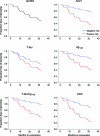Predicting MCI outcome with clinically available MRI and CSF biomarkers
- PMID: 21998317
- PMCID: PMC3198979
- DOI: 10.1212/WNL.0b013e3182343314
Predicting MCI outcome with clinically available MRI and CSF biomarkers
Abstract
Objective: To determine the ability of clinically available volumetric MRI (vMRI) and CSF biomarkers, alone or in combination with a quantitative learning measure, to predict conversion to Alzheimer disease (AD) in patients with mild cognitive impairment (MCI).
Methods: We stratified 192 MCI participants into positive and negative risk groups on the basis of 1) degree of learning impairment on the Rey Auditory Verbal Learning Test; 2) medial temporal atrophy, quantified from Food and Drug Administration-approved software for automated vMRI analysis; and 3) CSF biomarker levels(.) We also stratified participants based on combinations of risk factors. We computed Cox proportional hazards models, controlling for age, to assess 3-year risk of converting to AD as a function of risk group and used Kaplan-Meier analyses to determine median survival times.
Results: When risk factors were examined separately, individuals testing positive showed significantly higher risk of converting to AD than individuals testing negative (hazard ratios [HR] 1.8-4.1). The joint presence of any 2 risk factors substantially increased risk, with the combination of greater learning impairment and increased atrophy associated with highest risk (HR 29.0): 85% of patients with both risk factors converted to AD within 3 years, vs 5% of those with neither. The presence of medial temporal atrophy was associated with shortest median dementia-free survival (15 months).
Conclusions: Incorporating quantitative assessment of learning ability along with vMRI or CSF biomarkers in the clinical workup of MCI can provide critical information on risk of imminent conversion to AD.
Figures



References
-
- Devanand DP, Pradhaban G, Liu X, et al. Hippocampal and entorhinal atrophy in mild cognitive impairment: prediction of Alzheimer disease. Neurology 2007;68:828–836 - PubMed
-
- Mattsson N, Zetterberg H, Hansson O, et al. CSF biomarkers and incipient Alzheimer disease in patients with mild cognitive impairment. JAMA 2009;302:385–393 - PubMed
Publication types
MeSH terms
Substances
Grants and funding
LinkOut - more resources
Full Text Sources
Medical
